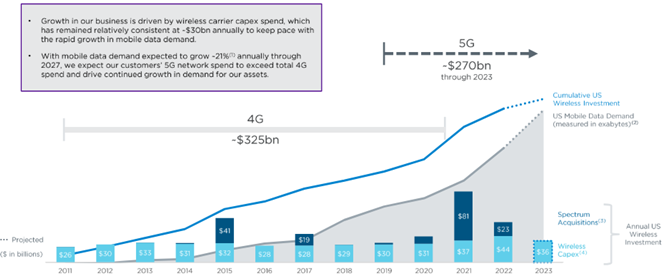What we learned from our recent trip to America (Part 2)
Despite the macro and geopolitical uncertainty, as well as certain company-specific risks, we believe there are still some very attractive investment opportunities in the US infrastructure market, and the recent trip reinforced this view.
While investment prospects for specific sectors vary, with different dynamics influencing earnings potential, we remain focused on companies that offer attractive valuations, exhibit stable earnings, predictable cash flows and have quality management teams.
In part one of this series, we discussed our observations of the political and economic environment in America. In this second and final part, we will look at the big issues facing different sectors of the broad listed infrastructure space in the US. We'll also share our insights from talking to management teams across the United States.
Electricity and gas-regulated utilities
The core message from many electric utility companies was the expectation for strong power load demand growth driven by a combination of factors depending on the state jurisdiction.
These include:
- Net population migration inwards (this could be negative for some states),
- Increased manufacturing (especially from tech companies supported by the CHIPS Act),
- Electrification (transport, space heating, and the oil/gas industry),
- Data centre demand and the energy needs of artificial intelligence (AI).
Despite management teams’ enthusiasm for load demand, investors were unclear on the impact on the investment proposition of infrastructure companies. The questions centred around – whether utilities could grow earnings at 4-8% during a period of benign or flat load demand growth, and if load growth is expected to be high single digits, then shouldn’t we expect much higher earnings growth? The resounding feedback from utility management teams was that increased load demand growth is expected to support the investment proposition of utilities, not change it.
Regarding demand driven by the development of data centres specifically, management outlined caution. It was felt that some of the demand being communicated by tech companies developing data centres such as Amazon, Meta, Microsoft and Google would not come to fruition.
To the degree that utilities made investments in generation and/or the network to facilitate this load, and it didn’t eventuate due to a decision by the tech company, the cost of that investment would be spread over the remaining customer base – negatively impacting the affordability of regular residential customers. This is a major concern for regulators and hence utility companies.
Utility companies are adopting various mitigation tactics to ensure that residential customers don’t take on the cost of investment to facilitate data centre load. Some companies spoke of adopting specific tariff structures for data centres, which had them pay for the incremental generation capacity to support their load, as well as a contribution to network investment. This required regulatory approval to implement. Most, if not all, utility companies required data centre developers requesting significant incremental power to sign long-term contracts with take-or-pay provisions, which meant that if the demand didn’t eventuate or didn’t last, the tech company would be required to cover the cost.
Utility management teams felt that if these mitigation tactics were adopted, the incremental demand from data centres would have the potential to support regular customer affordability by splitting shared network costs over a larger customer base.
Fundamentally, increased load growth supports customer affordability (reduces regulatory risk); enhances investment programs; and should support earnings growth if implemented correctly. Companies are unlikely to increase their earnings guidance significantly due to the cost of equity financing, and potential regulatory scrutiny. However, they could outperform on a fairly consistent basis.
In this space, we like Sempra (NYSE: SRE).
Water utilities
Water companies across the US are facing a busy regulatory calendar through 2024. Their discontent was focused on customer bill increases implied by the rate case filings.
Management teams of water utilities outlined that it was the usual course of action that these customer representative groups communicated discontent in response to proposed customer bill increases. They said that this has historically not impeded companies from achieving constructive regulatory outcomes and that the increased media coverage of the intervenor testimony was probably the new normal. They outlined the US being in an election year could be the driver for increased media coverage – the cost of living being an election theme.
Despite the increased media attention, there were examples where water companies were achieving constructive regulatory outcomes. American Water received a constructive regulatory decision from the administrative law judge in Pennsylvania, recommending revenue increases of around 60% of the company’s requested increase.
Additionally, in late June, SJW Group received a final decision on its rate case filing in Connecticut, which allowed for an increased return on equity of 30 bps to 9.3% (this could be improved with the achievement of certain performance metrics). This outcome was far superior to other water companies in the state, such as Aquerion, which had received an allowed return on equity of 8.7% in March 2023.
It was also clear from discussions with management that the need for investment in water networks was still very strong. The Environmental Protection Agency (EPA) had implemented new water quality thresholds regarding PFAS (including PFOA and PFOS) chemicals, or ‘forever chemicals’, in US drinking water supplies. Achieving this threshold, of 4.0 parts per trillion (ppt), requires significant investment and ongoing management on behalf of water companies, which management teams suggested was very achievable. The EPA was also considering Lead and Copper Rule Improvements (LCRI), which looked to identify and replace lead and galvanised water lines by 2037. Water companies believe the investment requirement to implement the renewed LCRI is understated by the EPA.
Irrespective of the deadline adopted by the EPA, it’s clear that massive investment is required to replace lead pipes, and water companies want to ensure that it’s facilitated while maintaining affordability for customers.
In this space, we like American Water (NYSE: AWK).
Midstream oil/gas
While passing through Houston, TX and Tulsa, OK, I met with several midstream (pipeline) oil/gas company management teams. They were generally optimistic regarding prospects driven by their belief in the long-term requirements for natural gas and refined products, combined with their current healthy credit positions and cash flow generation.
At the time of visiting, spot natural gas prices were around $2.50/MBtu, but the forward curve represented a strong contango. Management teams outlined that the upward trajectory in expected natural gas prices was probably supported by increased domestic and liquefied natural gas (LNG) demand through the back end of 2024 and into 2025.
However, the realisation of these higher gas prices was continually being pushed out and was somewhat mitigated by high gas storage levels. Current levels are approximately 500 Bcf higher than average and would take some time to dissipate for gas prices to escalate.
Irrespective of the short-term demand dynamics for natural gas, companies were aligned in believing that natural gas would be part of the energy mix in the long term, and an essential part of the energy transition process. Gas generation would support the rollout of renewables in addressing their intermittency, which would require the continued build-out of supporting infrastructure.
Predominantly, this required investment would be in capacity increases on major transportation pipelines and within storage assets. This trend is only exacerbated by the expected electrification dynamics and increasing demand from tech manufacturers and data centres.
In this space, we like Williams Companies (NYSE: WMB).
Communication towers
To varying degrees, the three US communications towers in 4D’s investment universe have experienced poor share price performance in recent years due to coinciding factors, including increasing interest rates; the negative cashflow impact from customer churn; and concerns regarding the ability of mobile network operator (MNO) customers to invest in upgrading networks to facilitate 5G. It seems the investment proposition of towers is still intact over the long term, but the short term presents challenges.
SBA Communications (NYSE: SBAC) and Crown Castle (NYSE: CCI) expect a continued drag on cash flow growth due to churn associated with the T-Mobile/Sprint merger. This churn occurs as contractual commitments end on tower agreements and T-Mobile/Sprint look to rationalise their overlapping coverage post their merger in 2020.
Management teams of the tower companies outlined that this is expected to be a headwind to cash flow growth in 2025 and 2026. It’s expected to be diminished/eliminated from 2027.
2023 represented a period of reduced MNO activity as a result of balance sheet stress, combined with a moderation in activity following a busy year in 2022 when MNOs quickly looked to establish 5G coverage, having just acquired a high(er) frequency spectrum in 2021. This reduced the service-related revenues earned by the tower companies, and it also heightened market concern that the trend of growing cashflow generation from 5G wasn’t going to be sustained.
The graph below shows the 2023 wireless capex of the MNOs was actually around the longer-term average, and despite being lower than 2022 (following the 2021 spectrum auctions), there is no sign that the 5G rollout will end.

More recently, there have been signs that the MNOs have increased activity slightly in rolling out 5G coverage. AT&T are continuing the rollout of its 5G coverage, while T-Mobile has achieved coverage across most of the US, and over time will look to increase density to facilitate higher 5G data uses.
We are not invested in this thematic at this time.


This is an abridged version of our larger Trip Insights piece and was written by Peter Aquilina, Portfolio Manager - Sustainability. Read the full version here.
3 topics
5 stocks mentioned
2 funds mentioned

